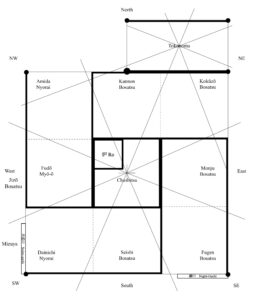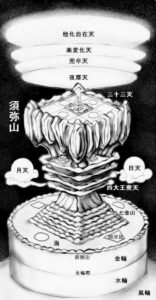Furo: Four Sacred Mountains

Mayu bu-ro, 眉風炉, eyebrow wind-hearth, with trivet, go-toku, 五徳, five-virtues, and ni-mon-ji hai-gata, 二文字灰形, two-letter-character ash-form with four peaks and valleys.

Diagram of yo-jō-han, 四畳半, four-mat-half, with directions and Buddhist guardians.

Diagram of Shu-mi-sen, 須弥山, Necessarily-increase-mountain, imagined Buddhist and Hindu center of the world. The square plateau is the realm of the San-jū-san-ten, 三十三天, Three-ten-three-heavens. The mountain is also called Sumeru.
In Chanoyu, the ideal portable brazier is Rikyū’s mayu bu-ro, 眉風炉, eyebrow wind-hearth. It requires a go-toku, 五徳, five-virtues, to support the kama, 釜, kettle. The preferred style of ash bed in the furo is the ni-mon-ji hai-gata, 二文字灰形, two-letter-character ash-form with four peaks and valleys.
Perhaps the four peaks of the ash bed are associated with mountains. Mountains are closely identified with Buddhism, especially Buddhist temples that bear san-go, 山号, mountain names.
Of the many sacred mountains in China, there are four that are most revered in Buddhism, and they are associated with a specific Bodhisattva/Bo-satsu, 菩薩, Grass-buddha.
Mount Putuo, Putuo Shan, Japanese, Fu-da-san, 普陀山, Universal-declivity-mountain, from the Sanskrit, Potalaka mountain, is dedicated to Guanyin/Kan-non Bo-satsu, 観音菩薩, See-sound Grass-buddha, Goddess of Mercy. Kannon attends A-mi-da Nyo-rai, 阿弥陀如来, Praise-increase-steep Like-become.
Mount Wutai, Wutai Shan, Japanese, Go-dai-san, 五台山, Five-support-mountain, is dedicated to Manjusri/Mon-ju Bo-satsu, 文殊菩薩, Literary-particularly Grass-buddha. Manjushri attends the Buddha together with Fugen Bosatsu.
Mount Jiuhua, Jiuhua Shan, Japanese, Kyū-ka-san, 九華山, Nine-splendid-mountain, is dedicated to Ji-zō Bo-satsu, 地蔵菩薩, Earth-keep Grass-buddha, who attends Amida Nyorai, together with Kannon Bosatsu. Jizō is the guardian of the world until the arrival of Maitreya/Mi–roku Bo-satsu, 弥勒菩薩, Increase-rein, the Buddha of the Future.
Mount Emei. E-mei Shan, Japanese, Ga-bi-san, 峨眉山, High mountain-eyebrow-mountain. People offer burning sandalwood near the mountain to send their ‘prayers to heaven’. Gabisan is dedicated to Bodhisattva Samantabhadra, Fu-gen Bo-satsu, 普賢菩薩, Universal-intelligence Grass-buddha, who attends Buddha, together with Monju Bosatsu.
Kannon is identified with the north, Monju with the east, Fugen with the south, and Jizō with the west, the paradise of Amida.
A fifth mountain may be identified with the charcoal fire in the center of the hearth, and that may be dedicated to Gautama Buddha, who preached and taught the way of salvation through the example of Amida. For Buddhists, the mountain, the land itself, is the ‘pure body of the Buddha’, San-shoku Shō-jō-shin, 山色清浄身, Mountain-color pure-pure-body, so that the mound of the charcoal fire may manifest the transition from the physical world to the spiritual realm. Nirvana, in Japanese, Ne-han, 涅槃, Soil(black)-decomposed. Total annihilation.
For further study, see also: Chanoyu and Zen Landscapes and Charcoal Sumi for Furo and Ro

